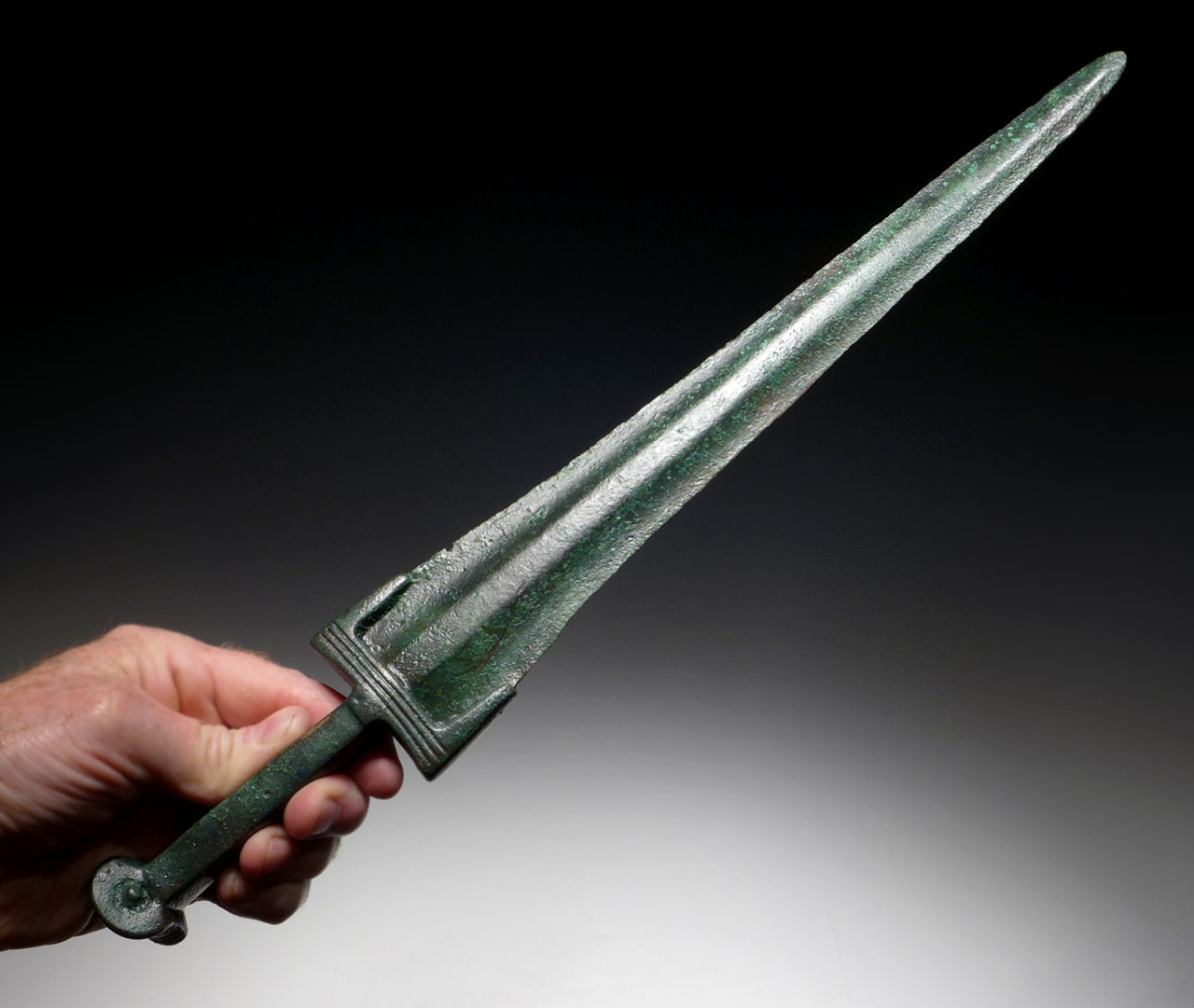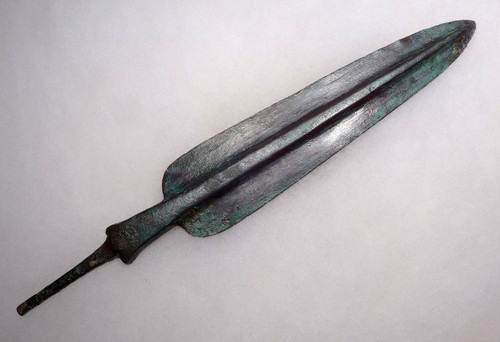Product Description
This MUSEUM-CLASS ancient bronze sword is from the Ancient Near Eastern / Luristan Bronze Age Culture. It was cast in bronze and features a decorative hilt and handle that is integral to the blade. The pommel is both aesthetic and functional as a striking end. This is THE FINEST example of this type we have ever offered. Unlike so many ancient bronze swords on the market that are made up of ancient parts of many swords, and include repair and restoration of modern replica parts, this superb example is COMPLETE AND ORIGINAL, and features perfect preservation! In ancient times, bronze swords were the most prized and expensive weapon that an individual could own. Very few soldiers owned or carried them because of their extreme cost, so swords were reserved for only the most noble, highest rank and wealthiest warriors. Because of their rarity in the ancient world, true authentic swords like this, are the rarest of all ancient weapons to find on the market, as well, making them one of the more promising investment antiquities to own.
It is certain that this sword would have been once owned and carried by an elite warrior or nobleman of great status. With its hard, hammer-forging to its sharp blade, this personal weapon would have been not only functional, but a weapon of pride and status in combat. In extreme close quarters, the heavy pommel would have been deadly effective as a striking weapon against an enemy soldier.
This INVESTMENT CLASS ancient bronze sword is INTACT with a full blade and tip and a complete ORIGINAL (NOT COMPOSITED FROM ANOTHER WEAPON AS MOST ARE IN THE MODERN MARKET) handle in solid bronze. The patina is incredible and this is a very well-balanced weapon. Specimens like this are becoming EXTREMELY rare in today's market.
This piece has been professionally cleaned and conserved in our lab, being treated with a special sealer developed and formulated by us specifically for ancient metal preservation. The patina shows beautiful traits only found in authentic ancient weapons such as a layered mineralized patina with encrustations. No active bronze disease. Bronze disease can be a problem in bronze artifacts and untreated, it can literally eat away an artifact over a short time of a matter of years and turn the piece to powder.
WARNING: There is an increasing number of fake Near Eastern (Luristan) bronze weapons on the market. As fine quality intact, original specimens become more scarce and techniques have become more sophisticated to fake these weapons. We have personally handled numerous extremely well-done fakes with extremely convincing patinas. The degree to which the fakers have been able to replicate patina to disguise their work requires an expert examination by highly experienced individuals. It is common to find very reasonably priced weapons that are made up of part original and part modern components or wholly modern pieces displaying elaborate artificial patinas. All purchases should include from the dealer a written guarantee of authenticity with unconditional and lifetime return policies regarding such guarantee.
HISTORY
With origins dating back to prehistory, the empire of ancient Iran was one of the world's first superpower civilizations by the time it had taken form in the second millennium B.C.. The various cultures that can be included in the former ancient Iranian Empire stretched across an enormous geographical region extending beyond what is called the Iranian Plateau. To gain insight as to just how large this area was, the Iranian Plateau alone, includes Iran, Afghanistan and Pakistan and comprises approximately nearly 4 million square kilometers (almost 1.5 million square miles). The area of ancient Iran included not only the massive Iranian plateau made up of the tribes of the Medes, Persians, Bactrians and Parthians, but also included groups as far west as the Scythians (an eastern Scythian tribe existed in parallel in Central Asia), Sarmartians, Cimmerians and Alans populating the steppes north of the Black Sea. To the eastern boundary of the empire, the Saka tribes dominated, spreading as far as Xinjiang, China. From a very early period, the ancient Iranian peoples have been historically documented to exist in two separate continuums - a western civilization (Persia) and an eastern civilization (Scythia).
The beginnings of ancient Iran trace back to an influx into the Iranian cultural region of bands of horse-mounted steppe nomads from Central Asia, speaking Indo-European languages. Some settled in eastern Iran but other groups migrated deeper to the west settling in the Zagros Mountains. These first people descended from the proto-Iranians, originating from the Central Asian Bronze age culture of what is called the Bactria-Margiana Complex (aka Oxus Civilization), dated 2200-1700 B.C..
This historical achievements and the breadth of diverse cultures included of this once great empire are too vast to adequately credit in this brief synopsis. The Islamic conquest of Persia in the middle of the 7th century A.D. and the collapse of the Sassanid Empire marked the end of once geographically expansive and culturally diverse ancient superpower.
The term LURISTAN references artifacts made by a society of semi-nomadic people that once lived in the mountainous region of Northwest Iran. Little is known of this ancient culture but the most impressive traces are that of the bronze artifacts they left behind that can be found in parts of present-day Turkey, Iran and Afghanistan. These include highly decorative equipment for their horses, ceremonial containers and numerous weapons ranging from simple utilitarian pieces on up to elaborate masterpieces of warfare.
It is theorized that the Luristan bronzes were crafted by the earliest existence of the Median empire but this has never been proven as written records of the Medes have not survived. The Medes were Indo-Iranian people originally from central Asia who settled in Northwest Iran in the 9th century BC and later defeated the Assyrian empire in 614 BC. Their success is short-lived and their empire which once stretched from central Iran to the Persian Gulf and Anatolia was overrun in 550 BC by the Persians.
 US DOLLAR
US DOLLAR
 EURO
EURO
 AUSTRALIAN DOLLAR
AUSTRALIAN DOLLAR
 CANADIAN DOLLAR
CANADIAN DOLLAR
 POUND STERLING
POUND STERLING




















